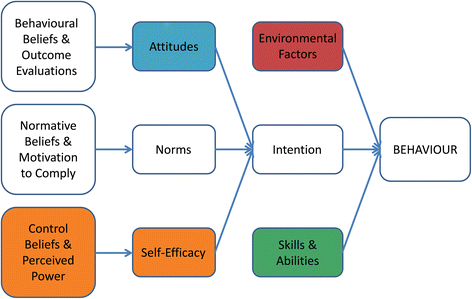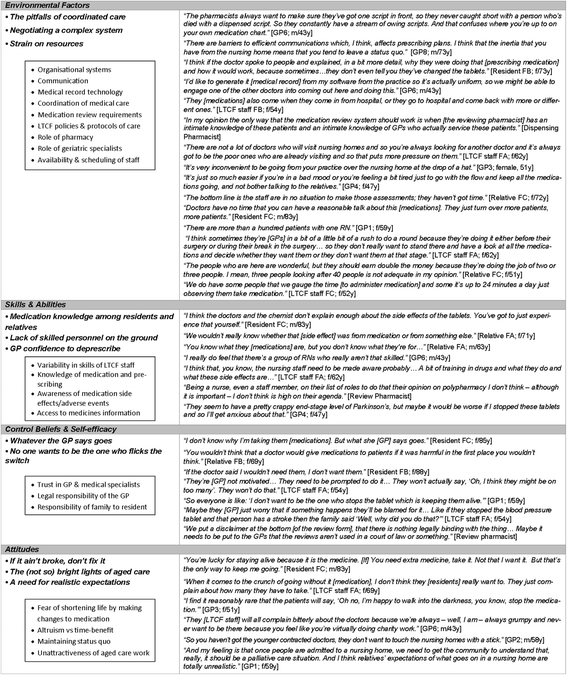Barricades and brickwalls--a qualitative study exploring perceptions of medication use and deprescribing in long-term care - PubMed (original) (raw)
Barricades and brickwalls--a qualitative study exploring perceptions of medication use and deprescribing in long-term care
Anna Palagyi et al. BMC Geriatr. 2016.
Abstract
Background: The co-administration of multiple drugs (polypharmacy) is the single most common cause of adverse drug events in the older population, and residents of long-term care facilities (LTCFs) are at particularly high risk of medication harm. 'Deprescribing'--the withdrawal of an inappropriate medication with goal of managing polypharmacy and improving outcomes--may improve the quality of life of LTCF residents. The RELEASE study sought to explore perceptions of medication use and the concept of deprescribing in LTCFs.
Methods: Focus groups and interviews were conducted with General Practitioners (GPs), pharmacists, nursing staff, residents and their relatives within three LTCFs in the Illawarra-Shoalhaven region of NSW, Australia. Audiotapes were transcribed verbatim and, using the Integrative Model of Behaviour Prediction as a framework, thematic analysis of transcripts was conducted using QSR NVivo 10.
Results: Participants acknowledged the burden of too many medications (time to administer, physical discomfort, cost), yet displayed passivity towards medication reduction. Residents and relatives lacked understanding of medicine indications or potential harms. Willingness to initiate and accept medication change was dependent on the GP, who emerged as a central trusted figure. GPs preferred 'the path of least resistance', signalling systems barriers (poor uniformity of LTCF medical records, limited trained LTCF personnel); time constraints (resident consultations, follow-up with specialists and family); and the organisation of care (collaborating with LTCF staff, pharmacists and prescribing specialists) as obstacles to deprescribing.
Conclusions: Targeted engagement is required to raise awareness of the risks of polypharmacy in LTCFs and encourage acceptance of deprescribing amongst residents and their relatives. GPs are integral to the success of deprescribing initiatives within this sector.
Figures
Fig. 1
An Integrative Model of Behaviour Prediction, adapted from Fishbein (2006). Themes emerging from the analysis were most clearly associated with five key elements: environmental factors, attitudes, control beliefs and self-efficacy, and skills and abilities
Fig. 2
Major themes (in bold) and intermediate coding framework (boxed) emerging from discussions about medication use and deprescribing in long-term care facilities with participants of the RELEASE study. GP general practitioner, f female, F facility, LTCF long-term care facility, m male, RN registered nurse, y years
Similar articles
- What factors are important for deprescribing in Australian long-term care facilities? Perspectives of residents and health professionals.
Turner JP, Edwards S, Stanners M, Shakib S, Bell JS. Turner JP, et al. BMJ Open. 2016 Mar 10;6(3):e009781. doi: 10.1136/bmjopen-2015-009781. BMJ Open. 2016. PMID: 26966056 Free PMC article. - Factors influencing deprescribing for residents in Advanced Care Facilities: insights from General Practitioners in Australia and Sweden.
Bolmsjö BB, Palagyi A, Keay L, Potter J, Lindley RI. Bolmsjö BB, et al. BMC Fam Pract. 2016 Nov 5;17(1):152. doi: 10.1186/s12875-016-0551-7. BMC Fam Pract. 2016. PMID: 27814691 Free PMC article. - Factors which influence the deprescribing decisions of community-living older adults and GPs in Australia.
Gillespie R, Mullan J, Harrison L. Gillespie R, et al. Health Soc Care Community. 2022 Nov;30(6):e6206-e6216. doi: 10.1111/hsc.14058. Epub 2022 Sep 27. Health Soc Care Community. 2022. PMID: 36165345 Free PMC article. - Deprescribing medications in older people: a narrative review.
Salahudeen MS. Salahudeen MS. Drugs Today (Barc). 2018 Aug;54(8):489-498. doi: 10.1358/dot.2018.54.8.2856495. Drugs Today (Barc). 2018. PMID: 30209443 Review. - A narrative review of the safety concerns of deprescribing in older adults and strategies to mitigate potential harms.
Reeve E, Moriarty F, Nahas R, Turner JP, Kouladjian O'Donnell L, Hilmer SN. Reeve E, et al. Expert Opin Drug Saf. 2018 Jan;17(1):39-49. doi: 10.1080/14740338.2018.1397625. Epub 2017 Nov 6. Expert Opin Drug Saf. 2018. PMID: 29072544 Review.
Cited by
- Deprescribing medicines in older people living with multimorbidity and polypharmacy: the TAILOR evidence synthesis.
Reeve J, Maden M, Hill R, Turk A, Mahtani K, Wong G, Lasserson D, Krska J, Mangin D, Byng R, Wallace E, Ranson E. Reeve J, et al. Health Technol Assess. 2022 Jul;26(32):1-148. doi: 10.3310/AAFO2475. Health Technol Assess. 2022. PMID: 35894932 Free PMC article. Review. - Physicians', Nurses' and Pharmacists' Perceptions of Determinants to Deprescribing in Nursing Homes Considering Three Levels of Action: A Qualitative Study.
Foley RA, Hurard LL, Cateau D, Koutaissoff D, Bugnon O, Niquille A. Foley RA, et al. Pharmacy (Basel). 2020 Feb 7;8(1):17. doi: 10.3390/pharmacy8010017. Pharmacy (Basel). 2020. PMID: 32046022 Free PMC article. - Nursing Home Residents' Thoughts on Discussing Deprescribing of Preventive Medications.
Thompson W, Jacobsen IT, Jarbøl DE, Haastrup P, Nielsen JB, Lundby C. Thompson W, et al. Drugs Aging. 2020 Mar;37(3):187-192. doi: 10.1007/s40266-020-00746-1. Drugs Aging. 2020. PMID: 31997117 - Attitudes Towards Deprescribing Among Older Adults with Limited Life Expectancy and Their Relatives: A Systematic Review.
Burghle A, Lundby C, Ryg J, Søndergaard J, Pottegård A, Nielsen D, Graabæk T. Burghle A, et al. Drugs Aging. 2020 Jul;37(7):503-520. doi: 10.1007/s40266-020-00774-x. Drugs Aging. 2020. PMID: 32537682 - Determinants of implementing deprescribing for older adults in English care homes: a qualitative interview study.
Warmoth K, Rees J, Day J, Cockcroft E, Aylward A, Pollock L, Coxon G, Craig T, Walton B, Stein K. Warmoth K, et al. BMJ Open. 2023 Nov 23;13(11):e081305. doi: 10.1136/bmjopen-2023-081305. BMJ Open. 2023. PMID: 37996237 Free PMC article.
References
- Somers M, Rose E, Simmonds D, Whitelaw C, Calver J, Beer C. Quality use of medicines in residential aged care. Aust Fam Physician. 2010;39(6):413–6. - PubMed
Publication types
MeSH terms
LinkOut - more resources
Full Text Sources
Other Literature Sources
Medical

